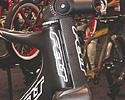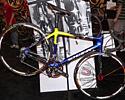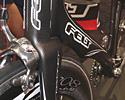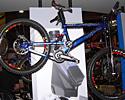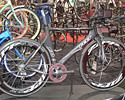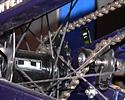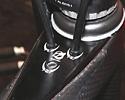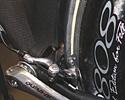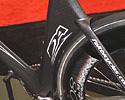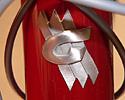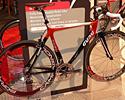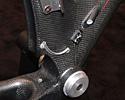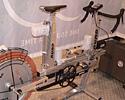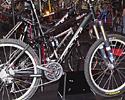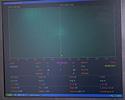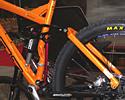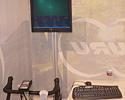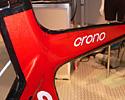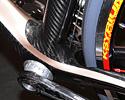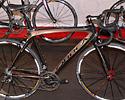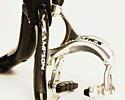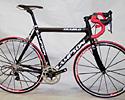
Recently on Cyclingnews.com |
Interbike show -
Las Vegas, Nevada USA, September 25-29, 2006
Main Page Previous Part Next Part
Part 20 - October 20
By James Huang in Las Vegas, NV
Felt adds longer-travel Redemption and new TT/Tri platform
Felt introduced its Virtue trail bike to us at this year's On Dirt Demo, and we found it to be a promising full-suspension platform with 130mm of well-controlled travel that still managed to offer exceptional pedaling response. Felt obviously has some fairly lofty goals for itself in the MTB market, though, as it also presented a second Equilink-based platform at the indoor expo. If the new chassis proves to mirror its design intentions as closely as on the Virtue, Felt will have gone from a near non-participant in the full-suspension wars to a legitimate contender in very short order.
The Redemption is the longer-travel compatriot to the Virtue with 165mm of rear wheel travel that has been tuned for more small-bump compliance while still retaining most of the Virtue's excellent pedaling traits. Redemption's chassis will be substantially beefier than the Virtue with items such as a 1.5" head tube and a rear disc mount that is tucked inside the rear triangle for better protection. Light weight is still a priority, however, as the frame also makes heavy use of hollow welded structures and light aluminum forgings. Target weight for the frame is just shy of 8lbs including shock and Felt anticipates that the Redemption will begin to trickle in to dealers around late March.
At the other end of the spectrum, Felt also launched a pair of brand-new all-carbon TT/Tri platforms, both of which feature dramatic NACA airfoil tube profiles and a host of aero goodies that were heavily influenced by wind tunnel testing. Aero features include the close-fitting front and rear wheel cutouts, chainstay-mounted rear brake, well-executed internal cable routing (arguably the best we've encountered), and narrower 1" front end.
In addition, Felt's top DA model incorporates the radical-looking Bayonet Steering System. In this setup, the steerer tube is effectively placed out ahead of the frame, similar to what BMC had done on its uber-pricey TT01 Time Machine, for better aerodynamics and a reported 60% increase in steering stiffness. Felt's version improves on that concept through the use of a standard 1" head tube on the frame, thus allowing the use of a conventional fork and stem if needed.
Frame weight on the top-of-the-line DA is reported to be 1200g, while the identically shaped second-tier B2 will come in slightly heavier at 1350g.
Felt's F-series road racing frames carry over mostly unchanged for 2007, with the exception of new fiber layups that are said to increase drivetrain and torsional rigidity. A new Z-series geometry offers slightly more upright positioning and stabler handling, both in modular monocoque carbon fiber construction as well as conventional welded aluminum.
More info: www.feltracing.com
Interbike 2007 sees second coming of Orbea's groundbreaking Orca
Orbea's Orca made a big splash in 2004 with its surprisingly smooth ride, competent weight and performance, and striking styling. Sensing that its flagship was beginning to lose its luster, though, Orbea's designers went back to square one to develop an all-new Orca for 2007 that sought to not only improve on the performance characteristics on the original but also make a larger visual statement.
We can't comment firsthand on the performance aspect of the new Orca until we throw our legs over one, but the numbers are certainly impressive. The first generation Orca's even mix of high modulus Toray M30s fibers and medium modulus T700s has now also been replaced by a 50/50 blend of the same M30s plus Toray's top-end M40J carbon that is molded as a true monocoque. On average, the new Orca is said to be 11% lighter, but also 17% stiffer laterally out back as well as 23% more rigid in torsion up front while keeping the vertical compliance in line with the original. Frame weight is now claimed to be sub-1kg for a 54cm frame, and the entire frameset (including the fork and headset) a very competitive 1425g.
If nothing else, the new Orca is certainly an aesthetic home run thanks to a dramatic two-toned paint job that highlights the company's new Size Specific Nerve (SSN) tube shaping as well as a host of clever details. A pronounced rib runs uninterrupted on either side of the frame from the tips of the seatstays all the way back around to the tips of the chainstays. Orbea claims this "nerve" is what allows for the tuned stiffness increases, and altering the nerve width, wall thickness, and fiber layups on each frame size keeps the ride quality consistent across the board. Five men's sizes will be offered, ranging from 48-60cm, as well as two women's-specific sizes. We can't wait to try one!
More info: www.orbea.com, www.orbea-usa.com
Sampson's SAS takes the buzz out
Sampson Sports didn't have an official booth set up at Interbike this year, but that didn't stop us from checking out a few things that are coming from them in '07. First up is a pair of integrated aero bars, both of which feature full carbon fiber construction - with the exception of some high-stress areas where aluminum is also embedded. Straight and upswept extensions will be available, and the length will be adjustable via a tidy collet system. Plugging in to the ends of the base bar will be Sampson's new Stratics TT brake lever which offers a spring-loaded return spring and comfy form-fitting rubber cap at just 64g each. Optional carbon fiber blades will shave 6g per side.
The new Stratics AL-1 road brakes feature a clean dual-pivot design and forged aluminum construction. Weight is claimed to be a surprisingly Dura-Ace-like 312g per pair, but suggested retail will be a bargain basement US$119. An even lighter AL-2 is on the way with a claimed weight of just 265g for the pair.
Sampson's Shock Attenuation System isn't new, but our brief test ride on the company's carbon fiber Diablo model was the first time we'd sampled the technology ourselves. The SAS concept is rather straightforward: three different durometers of lightweight urethane foam are injected directly into the frame tubes in an effort to quiet the ride and damp vibration.
The ride quality of the Diablo was remarkably smooth and settled, in spite of the rather enormous tube diameters. Expansion joints, broken pavement, and even intentional forays into the gutter were all met with an uneventful 'thud', and I found myself checking the tire pressure on more than one occasion. Filling the tubes with urethane seems kind of silly at first, but Sampson is clearly on to something here. We'll see if we can't get our hands on a longer-term test bike for a proper evaluation, but the initial impressions were very favorable.
More info: www.sampsonsports.com
Guru's Dynamic Fit Unit promises to revolutionize bike fit
Montreal-based custom builder Guru Bicycles introduced what was easily one of the most talked-about non-bicycles at this year's Interbike. Guru's new Dynamic Fit Unit integrates RacerMate's Velotron-derived computer-controlled eddy current resistance unit into an adaptable chassis with adjustable handlebar and saddle positioning, much like Tiemeyer Cycles' PositionCycle. Also like the PositionCycle, all of RacerMate's standard functions are built in, including power output, cadence, heartrate, speed, distance, time and calories, and the SpinScan pedal stroke efficiency program.
In Guru's case, though, all of the adjustments are computer-controlled with precision stepper motors. As such, the rider's position can be continually altered in order to optimize each of the performance parameters (which are displayed in real-time on the computer screen) without even having to dismount between changes.
Once the fit is optimized, the X-Y coordinates of all of the key contact points can be instantly recorded so that the position can then be replicated on the customer's actual bike. If a custom frame is in order, the numbers can even be immediately uploaded to Guru's servers in Montreal which can then send back a proposed custom frame geometry before the rider even gets off of the trainer! The only thing left for Guru to do in order to deliver truly instant gratification is to figure out a way to send the actual frame via email. Expect to see this thing hitting Guru's more serious dealers around February.
In addition to the new fit system, Guru also introduced limited edition versions of its Geneo (formerly called Maestro) road frame and Chrono TT/Tri chassis. Guru touts each as being the only fully customizable seamless monocoque carbon frames of their type currently available (Seven's carbon frames might be included in this list also, but their method of construction still isn't public knowledge). The Limited Edition Geneo will be dressed in Campagnolo's new Record group with Bora carbon wheels, while the Limited Edition Chrono will wear Shimano's Dura-Ace group with Zipp's 606 wheelset. Both will be offered exclusively with fully custom geometry and covered in Guru's new "Premium" paint.
More info: www.gurubikes.com
Pacific Cycles swaddles Schwinn and GT children in carbon fiber
More than one industry expert predicted the demise of Schwinn and GT upon their purchase by Pacific Cycles in 2001. Instead, Pacific seems to have injected some much needed capital and energy into the lines, and 2007 sees heavy doses of carbon fiber being used by the two brands for both road and mountain bikes.
The Peloton is Schwinn's first all-carbon road frame, featuring a mix of T700 and TX50 carbon fibers. As with just about every other carbon frame these days, Schwinn claims the new Peloton displays very high torsional and lateral rigidity with good vertical compliance, yada, yada, yada. What is virtually undeniable, though, is the exceptional value Schwinn brings to the table with the new line.
The sub-16lb top-end Peloton LTD boasts a full monocoque carbon fiber fork, Dura-Ace 10spd drivetrain, Truvativ Rouleur Carbon crankset, Mavic Ksyrium ES wheels, Ritchey WCS carbon fiber cockpit, and fi'zi:k Arione saddle for just US$3999 retail. Ultegra and 105-equipped models offer equally high value at just US$2299 and US$1599, respectively.
GT updates its XC i-Drive platform with a new carbon fiber main frame. The new i-Drive 4 Carbon weighs about the same as last year's aluminum version, but the material substitution results in a marked increase in rigidity for more precise and predictable handling, not to mention swoopier styling. As equipped with a Shimano XT/XTR drivetrain, Fox suspension and DT wheelset, the i-Drive 4 Carbon comes in at a retail price of US$2999.
More info: www.schwinn.com, www.gtbicycles.com
Photography
For a thumbnail gallery of these images, click here
Images by James Huang/Cyclingnews.com
- Felt's Bayonet Steering System places the "steerer tube" ahead of the head tube for improved aerodynamics and greater steering precision.
- Down tube cutout on the DA and B2 smooths airflow coming off of the front wheel.
- Felt's new DA makes liberal use of NACA airfoil tubeshapes and some interesting details to increase aerodynamic efficiency.
- Internal cable routing on the new DA and B2 is among the best we've encountered. Full-length sleeves guide the housing all the way through the frame, and military-spec seals keep water and sweat out.
- Rear brake on the DA is mounted low and behind the seat tube.
- Seat tube cutout on the DA closely follows the profile of the rear wheel to smooth airflow. Micro-adjustable horizontal dropouts make for precision adjustment.
- The red Equilink that ties the upper and lower links of Felt's new suspension system is the key to the system, offering precise axle path and chain growth tuning.
- Full-length sleeves in Felt's internal cable routing system guides the housing all the way through the frame to the appropriate exit, which is also clearly marked.
- The Redemption is Felt's longer-travel Equilink platform, offering 165mm of rear wheel travel in a beefy package that should still pedal well.
- The rear end of the Redemption is retuned for better small bump compliance relative to the firmer feel of the XC-specific Virtue.
- The bottom bracket shell and pivot of the Virtue is made up of two aluminum halves that are keyed for accurate alignment and welded.
- The new Orca boasts a more purposefully-reinforced bottom bracket than before with more material on the sides but less up top.
- Clever details abound on the new Orca, including these cutout fork tips.
- Orbea is hoping its new Orca will make as much of an impact as the original.
- The aluminum head tube badge on the new Orca also doubles as the derailleur housing stop.
- The new seat collar is clearly a design element here, but can be replaced with a standard clamp in a pinch. Seatpost diameter has increased to 31.6mm.
- Beefy wishbone suggests a harsh ride out back, but Orbea assures us that the ride quality of the original Orca remains unchanged.
- The "nerve" is a rib that runs continously around the frame and allows Orbea to tune each size Orca to ride identically.
- Orbea will also offer a women's-specific Diva model of the Orca in two sizes.
- Orbea Orca designer Miriam Bengoetxea poses with the fruit of her labor.
Images by Sampson Sport
- Sampson's new integrated aero bars offer carbon construction and neatly-done adjustability.
- The Diablo sports Sampson's intriguing Shock Attenuation System, which sounds goofy on paper, but actually works remarkably well.
- A new TT lever from Stratics will be offered with either aluminum or carbon fiber blades. The new AL-1 brake is surprisingly light and cheap.
Images by James Huang/Cyclingnews.com
- Guru's Chrono carbon fiber TT/Tri frameset utilizes some interesting shaping around the bottom bracket area.
- Guru will offer two limited edition models for 2007, including this Chrono with Dura-Ace componentry and Zipp 606 wheels.
- Paint quality on Guru's Chrono Limited Edition was stunning.
- Guru's new Dynamic Fit Unit interfaces with a computer to adjust the rider position and send data to company servers in Montreal where custom geometries can be produced nearly instantly.
- The Dynamic Fit Unit incorporates all of RacerMate's standard features, such as power, speed, and SpinScan.
- Guru's Dynamic Fit Unit promises to revolutionize bicycle fit with a computer-controlled position adjustment and instant feedback.
- The Maestro will now be called the Geneo, and a limited edition version will be offered for 2007 including Campy Record componentry and Bora carbon fiber wheels.
- Nicely done head tube badge on the Guru Geneo.
- GT's new carbon fiber road frame finally makes it to production for 2007.
- The top cross-country i-Drive now gets a carbon fiber front end for better handling precision.
- GT's revolutionary iT1 now utilizes a freewheel at the rear hub for smoother running while coasting.
- GT's iT1 incorporates a Shimano Nexus internally-geared hub in the center of the bike.
- Schwinn's full-carbon Peloton boasts impressive value in a high-performance package.

